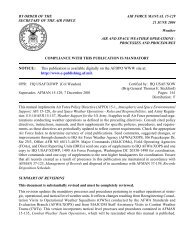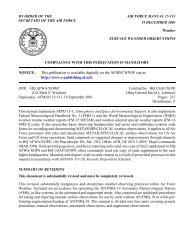Joint Metoc Handboo - IHMC Ontology and Policy Management
Joint Metoc Handboo - IHMC Ontology and Policy Management
Joint Metoc Handboo - IHMC Ontology and Policy Management
Create successful ePaper yourself
Turn your PDF publications into a flip-book with our unique Google optimized e-Paper software.
7-Navy<br />
7.4 Navy METOC Data<br />
7.4.1 Navy METOC Data Sources.<br />
The following represent the most significant sources of METOC data within the Navy<br />
tactical structure: Battleforce Surface Ships, Carrier Air Wing, Maritime Patrol Aircraft,<br />
<strong>and</strong> Submarines. METOC observations taken by these units consist of surface weather,<br />
upper air, pilot reports (PIREPs), <strong>and</strong> bathythermograph data.<br />
• Battle Force Surface Ships. All Battle Force/Group surface combatants (aircraft<br />
carriers, cruisers, destroyers, frigates, amphibious, mine warfare, <strong>and</strong> logistics support<br />
ships) provide METOC surface weather observations every six hours while at sea.<br />
These reports are submitted on the synoptic hours of 0000Z, 0600Z, 1200Z, <strong>and</strong><br />
1800Z. If visibility is less than 1 NM, winds exceed 35 knots, or the seas exceed 12<br />
feet, the reporting rate increases to every three hours until the condition(s) improve.<br />
All ships at sea are required to take regular observations, but where ships are steaming<br />
in company or in close proximity the Officer in Tactical Comm<strong>and</strong> (OTC) may<br />
designate one ship to report for the group.<br />
- All anti-submarine warfare (ASW) ships (cruisers, destroyers, <strong>and</strong> frigates) collect<br />
bathythermograph (BT) data by dropping an expendable temperature sensor into<br />
the sea. The collection rate of BT data is driven by operational requirements.<br />
- Upper-air observations are regularly collected by those Navy vessels with a<br />
permanently assigned METOC division (OA Division) or embarked Mobile<br />
Environmental Team (MET). Upper-air observations are taken at the synoptic<br />
times of 0000Z <strong>and</strong> 1200Z, as operations permit.<br />
• Carrier Air Wing. Aircrews provide meteorological observations, pilot reports<br />
(PIREPs), as specified by their mission, or when required in areas of sparse data (e.g.,<br />
oceanic, target weather). PIREPs are submitted via radio or upon return from the flight<br />
to the carrier weather office (or shore-based weather office, if the aircraft recover<br />
ashore).<br />
• Maritime Patrol Aircraft. Aircrews provide meteorological observations as specified<br />
by their mission, or when required in areas of sparse data (e.g., oceanic). Aircraft<br />
observations are transmitted when radio contact is made, or are delivered, along with<br />
observations of unexpected en route weather, to the NAVMETOCCOM activity at the<br />
air station at which the aircraft l<strong>and</strong>s. Sonobuoy-equipped aircraft take airborne<br />
expendable bathythermograph (AXBT) observations in open ocean areas where depths<br />
exceed 100 fathoms. A minimum of one BT observation is taken during each antisubmarine<br />
warfare (ASW) flight that uses sonobuoys. Collected data is submitted to<br />
the NAVMETOC activity at the air station at which the aircraft l<strong>and</strong>s.<br />
• Unmanned Aerial Vehicles (UAVs) <strong>and</strong> Unmanned Underwater Vehicles (UUVs).<br />
UAVs <strong>and</strong> UUVs are an increasingly important source of weather <strong>and</strong> oceanographic<br />
7-7




